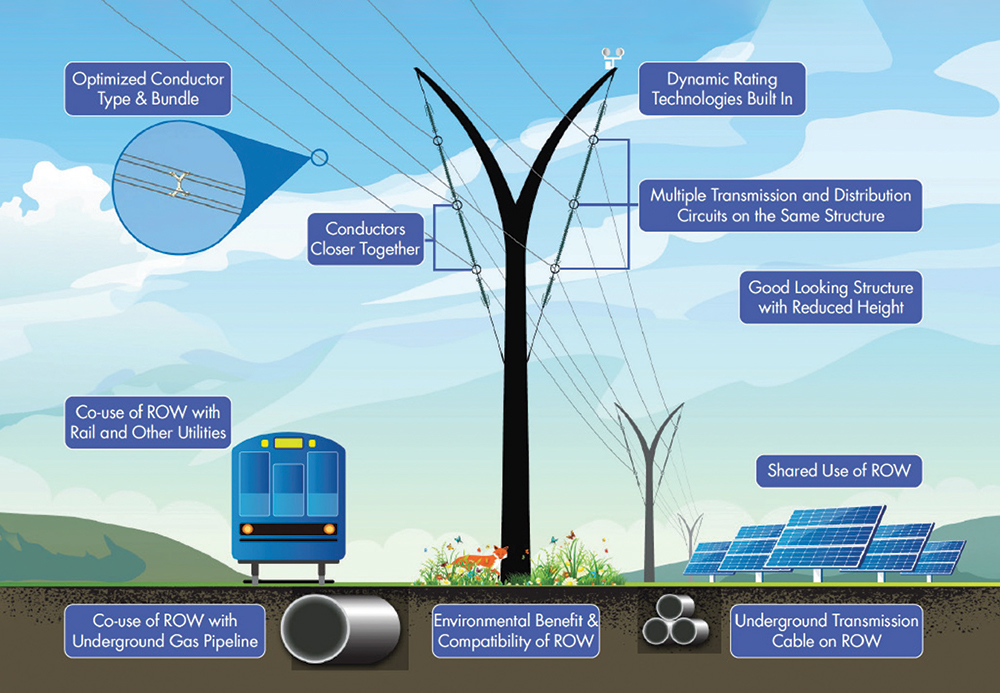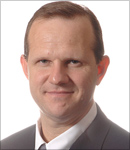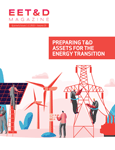For this combined issue of the magazine, Vice President of Transmission and Distribution Infrastructure for EPRI Andrew Phillips shares his thoughts on the future of T&D infrastructure in the global energy transition.
Last year, the Biden Administration announced new targets for the United States’ greenhouse gas emissions goals by 2030. The announcement acknowledged that meeting these goals would require investment and innovation in America’s aging utility infrastructure.
As a result, utilities are exploring how to meet and support these energy goals by using and optimizing existing assets. Research from the Electric Power Research Institute (EPRI) shows that leveraging the existing energy infrastructure — including hydropower, nuclear and transmission assets — is a realistic option to provide low-cost carbon reductions.
For transmission and distribution (T&D) assets, this work focuses on optimizing two key resources: transmission lines and rights-of-way (ROWs). Upgrading assets may allow for expanded capacity and operational capabilities but should always be done on a case-by-case basis. This ensures site-specific understanding and assessment of costs and engineering challenges.
Increasing demand on assets
The global energy transition continues to move away from fossil-fuel-based energy generation to more sustainable, clean energy resources such as wind and solar photovoltaic (PV). In many cases, the location of these variable resources is different from the location of the existing fossil fleet. In addition, reducing the greenhouse gas emissions of residential, transportation and industrial sectors may be realized by increased electrification, which may increase the demand for electricity.
To meet the demands of integrating more renewables and the potential increase in the electricity demand, the transmission system must evolve, which will require an increase in the transmission system capacity in many regions. As a result, many new miles of new transmission lines — and the associated grid assets — are predicted to be required.
Utilities should expect new assets to be subject to stricter resilience and reliability requirements due to society’s increasing dependence on electricity. In addition to more stringent requirements, identifying and financing new siting locations may also present a challenge, particularly in urbanized, highly populated areas.
For these — and many more — reasons, utilities may be considering if there is potential to optimize and leverage their existing assets and resources to meet these needs. EPRI research shows that (despite technical challenges) increasing the power transfer capacity of existing transmission systems and utilizing existing ROW may offer another feasible option for utilities.
EPRI’s research finds this work shouldn’t be approached in a silo but as part of a more holistic evaluation that accounts for all aspects of the transmission process. This includes grid operations and planning and addressing new and existing asset designs. With decades-long industry experience, EPRI’s transmission team works closely with utility members nationwide to execute increased power flow projects through detailed modeling, analysis, lab testing and field implementations which evaluate cost, reliability, compatibility and future maintenance needs.
One of the first areas to explore to identify the site-specific challenges is determining the source of the transmission capacity — or power flow — limitation. In alternating current (ac) lines, the power flow limitation can be one of the following:
- Thermally limited: This applies to the rated current of the conductor system, which is primarily determined by the characteristics of the conductor (e.g., the area of aluminum strands).
- Voltage drop limited: This occurs when the voltage at the end of the line drops below the established operational limits due to the current flowing through the line impedance.
- Stability limited: On long lines, small changes in load can result in unstable receiving-end voltages due to the relatively large series impedance of the line.
In general, the dominant limitation depends on the line length. Depending on the type of limitation, the power flow capacity of a line can be increased by line uprating, voltage upgrading, or reducing impedance.
Providing increased capacity with existing ROWs
All three options for increasing power flow capacity can be explored on existing ROWs. Utility ROWs are strips of land used to construct, operate, maintain and repair transmission lines. These lands are acquired through a lengthy process subject to regulatory requirements and public opinion. The process can often be challenging and costly, which makes optimizing existing ROWs a viable option that should be explored whenever possible as a potential solution to meeting increased transmission capacity.
Line uprating
For short lines, the current-carry capacity can be increased by 5 to 50% through various methods aimed at addressing conductor temperature. This, in turn, impacts sag and the probability of exceeding the conductor system temperature rating.
The methods are all situation-dependent and vary in the power flow increase provided, as well as the engineering challenges and experience of the industry applying these methods. Some methods include reconductoring by increasing the temperature type, rating, size, or the number of conductors per phase; implementing ambient adjusted line ratings, or using real-time or forecasted ambient temperatures to predict the conductor temperature (assuming all other factors in the rating equations are consistent); or adjusting static ratings using a risk-informed approach based on probabilistic assessment of the simultaneous occurrence of variables such as minimum wind speed, maximum temperature and load.
Voltage upgrading
Voltage upgrading can increase line capacity by more than 100% by raising the operating voltage. In some cases, moderate increase can be achieved with limited physical changes and no impact on reliability.
AC to DC conversion
Converting an existing ac line to HVDC operation can also significantly increase the capacity of longer lines for the same insulator lengths and phase spacing. In some cases, the capacity increases up to 250%.
While this process creates engineering challenges (such as electric field issues, contamination flashover and audible noise), all can be successfully mitigated and managed through existing engineering practices. In most cases, the biggest challenge facing conversions is cost, since converter stations connecting HVDC lines to the ac grid are expensive. However, they offer additional capabilities such as increased controllability and islanding, which can aid the larger network operation.

Credit: Electric Power Research Institute
(click to enlarge)
Adding cables to ROW
Another option for increasing capacity comes in the form of adding cables. Cables can be placed below ground or on the surface. Generally, underground cables are the most expensive option due to the civil engineering and cable material required. Still, communities often prefer underground cables because they are less visible and the ROW is already acquired.
As with the other methods, site-specific assessment is needed to determine the challenges and mitigation steps. These assessments include access for maintenance, corrosion and other factors.
Implications
These methods provide broad ranges in impact to power-flow increase, costs and other key factors such as reliability, compatibility and maintainability. When increasing the power flow of an existing ROW, utilities should evaluate potential benefits compared to the cost, reliability and engineering challenges. These challenges should always be addressed through specialized knowledge, analysis and testing combined with field implementation and monitoring.
 Andrew Phillips is vice president of Transmission and Distribution Infrastructure for EPRI. He provides executive oversight and direction for research, development and demonstration programs addressing asset management, operations, planning and integration, including issues and opportunities in diverse areas such as data analytics, reliability, robotics and sensors. Since joining EPRI in 1998, he has led various research programs and initiatives covering transmission and distribution infrastructure and systems.
Andrew Phillips is vice president of Transmission and Distribution Infrastructure for EPRI. He provides executive oversight and direction for research, development and demonstration programs addressing asset management, operations, planning and integration, including issues and opportunities in diverse areas such as data analytics, reliability, robotics and sensors. Since joining EPRI in 1998, he has led various research programs and initiatives covering transmission and distribution infrastructure and systems.
Dr. Phillips earned a Bachelor of Science, Master of Science and Doctor of Philosophy in electrical and electronics engineering from the University of the Witwatersrand, in Johannesburg, South Africa.







